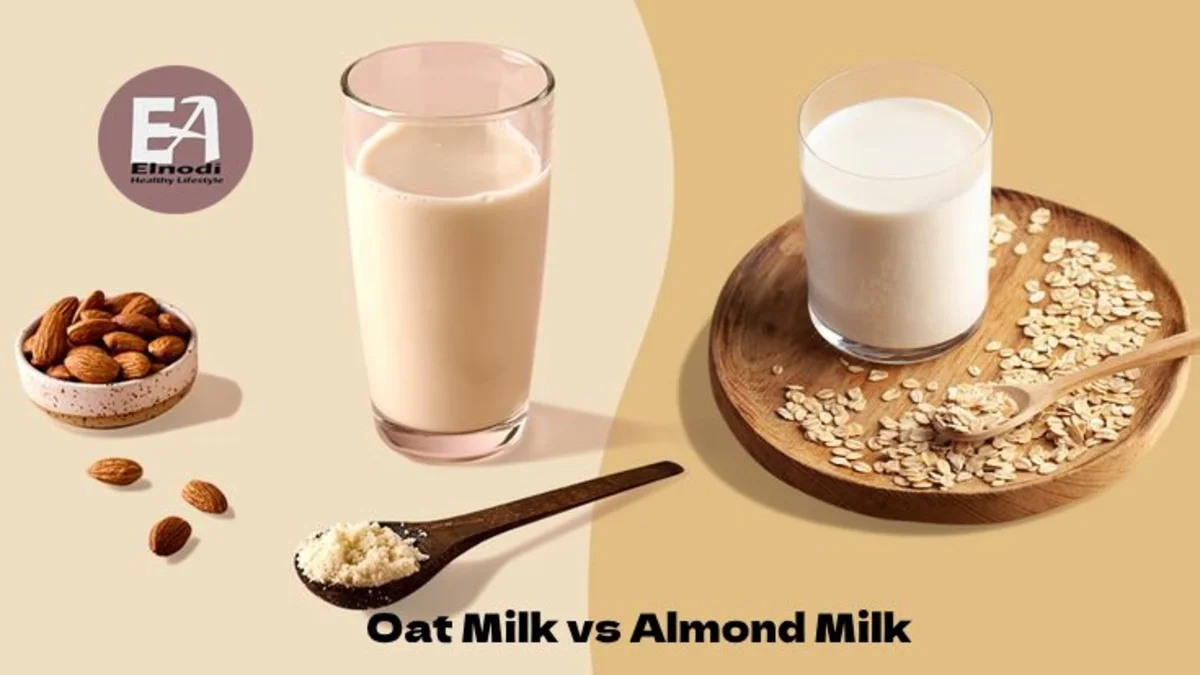When it comes to non-dairy milk alternatives oat milk and almond milk are two popular choices. But which one is truly the better option? Is it all about taste, or are there significant differences in nutrition and other factors to consider?
With the rise in popularity of plant-based diets and concerns about sustainability in the dairy industry, many people are turning to alternatives like oat milk and almond milk. Both options offer a creamy texture and pleasant taste, but there are some key distinctions worth exploring.
Table of Contents
Oat Milk vs Almond Milk
Nutritional Comparison
Oat Milk
At the forefront of plant-based milk alternatives, oat milk has gained immense popularity in recent years.
Made by blending oats with water and then straining the mixture, oat milk offers a creamy texture and a slightly sweet flavor.
Here are some key points to consider when comparing oat milk to other non-dairy alternatives:
- Allergen-Friendly: Oat milk is free from common allergens like dairy, nuts, and soy, making it an excellent choice for those with dietary restrictions or allergies.
- Sustainability: Oats are more environmentally friendly compared to almonds, which require a significant amount of water to grow. Choosing oat milk can be a more sustainable option for environmentally conscious consumers.
- Versatility: Oat milk’s mild flavor and creamy consistency make it a versatile option for various uses, including coffee, baking, and cooking.
In conclusion, oat milk presents a compelling alternative to traditional dairy milk and other plant-based options, offering a blend of taste, nutrition, and environmental sustainability.
Higher in calories and carbohydrates
Oat milk is a great option for individuals who are looking to add more calories to their diet or those who require a higher carbohydrate intake.
This makes it a suitable choice for people who are more active or looking for a quick energy boost.
On the other hand, almond milk is lower in calories and carbohydrates, making it a preferred choice for those who are watching their calorie or carbohydrate intake.
Almond milk is a great option for individuals who are trying to lose weight or reduce their overall carbohydrate consumption.
Ultimately, the choice between oat milk and almond milk depends on individual preferences and dietary needs.
Whether you opt for oat milk’s higher calorie and carbohydrate content or almond milk’s lighter profile, both can be nutritious additions to your diet
Contains more fiber and protein
When comparing oat milk vs almond milk, one significant factor to consider is the amount of fiber and protein each provides.
Oat milk typically contains more fiber and protein than almond milk, making it a popular choice for individuals looking to increase their intake of these nutrients.
Key Points:
- Protein Content: Oat milk also offers more protein than almond milk. Protein is vital for building and repairing tissues, supporting immune function, and maintaining muscle mass. By opting for oat milk, you can boost your protein intake without relying solely on animal-based sources.
- Overall Nutrition: With its superior fiber and protein content, oat milk emerges as a nutritious alternative to almond milk. Whether you’re aiming to improve your digestive health, feel fuller for longer, or increase your protein consumption, incorporating oat milk into your diet can be a wise choice.
In summary, if you prioritize fiber and protein in your diet, oat milk may be the better option between oat milk vs almond milk.
Fortified with vitamins and minerals
Exploring the Benefits of Fortified Oat Milk and Almond Milk
When comparing oat milk vs almond milk, one key aspect to consider is whether they are fortified with essential vitamins and minerals.
Fortification plays a crucial role in enhancing the nutritional value of these plant-based milk alternatives.
Key Points:
- Health Benefits: Vitamin D supports bone health and boosts the immune system, while calcium is essential for maintaining strong bones and teeth. Iron is crucial for transporting oxygen in the body, and vitamin B12 is important for nerve function and energy levels.
- Customized Formulations: Manufacturers may tailor the fortification process to address specific nutritional needs, making these milk alternatives suitable for individuals with dietary restrictions or preferences.
- Convenience: Fortified oat milk and almond milk offer a convenient way to consume essential vitamins and minerals, especially for those following a plant-based diet.
In conclusion, opting for fortified oat milk or almond milk can be a nutritious choice, providing a valuable source of essential vitamins and minerals for overall well-being.
Almond Milk
Almond milk has gained immense popularity in recent years as a dairy-free alternative to traditional cow’s milk.
It is made by blending almonds with water and then straining the mixture to create a smooth, creamy liquid.
Here are some key points to consider when comparing almond milk with oat milk:
- Nutrition: Almond milk is naturally low in calories and can be a good source of vitamin E, which is beneficial for skin health. However, it is lower in protein compared to cow’s milk and oat milk.
- Sustainability: Almonds require a considerable amount of water to grow, leading to concerns about the environmental impact of almond milk production. In contrast, oat milk tends to have a lower water footprint.
- Allergies: Almond milk is a popular choice for individuals with lactose intolerance or dairy allergies, providing a suitable alternative that is free from animal products.
In conclusion, almond milk offers a tasty and versatile dairy-free option, but it’s essential to consider factors like nutrition, sustainability, and allergies when choosing between almond milk and oat milk.
Lower in calories and carbohydrates
On the other hand, almond milk is lower in calories, making it a favorable option for those watching their caloric intake.
In terms of carbohydrates, oat milk typically contains more carbs than almond milk because of its oat composition.
This higher carbohydrate content in oat milk can be beneficial for individuals looking for a quick source of energy.
However, for those following a low-carb diet, almond milk might be the preferred choice due to its lower carbohydrate content.
Understanding the differences in calorie and carbohydrate levels between oat milk and almond milk allows consumers to make informed choices based on their dietary needs and preferences.
Whether you opt for the creaminess of oat milk or the lightness of almond milk, both alternatives offer unique nutritional profiles to cater to various health goals.
Lacks fiber and protein compared to oat milk
Almond milk is known for being lower in both fiber and protein compared to oat milk.
Let’s delve into why this difference matters and how it can impact your overall nutrition:
- Protein Content: While almonds are a good source of plant-based protein, almond milk itself has lower protein content compared to oat milk. Protein is essential for muscle repair, immune function, and overall health. Opting for oat milk, which typically contains more protein, can be advantageous for individuals seeking to boost their protein consumption.
By understanding the differences in fiber and protein content between almond milk and oat milk, you can make an informed choice based on your nutritional needs and preferences.
Often fortified with vitamin E
When comparing oat milk vs almond milk, it is essential to consider that both options are often fortified with essential nutrients to enhance their nutritional profiles.
One common fortification found in both varieties is vitamin E.
This key nutrient plays a crucial role in promoting overall health and well-being.
Here are some key points to consider about the fortification of oat milk and almond milk with vitamin E:
- Both oat milk and almond milk are excellent sources of this fat-soluble vitamin when fortified.
- Consuming vitamin E regularly can support immune function and promote healthy skin.
- Fortified vitamin E in plant-based milks can help individuals meet their daily intake requirements more easily.
- Including these fortified options in your diet can be a convenient way to boost your vitamin E levels.
In conclusion, the fortification of oat milk and almond milk with vitamin E enhances their nutritional value, providing consumers with an easy and delicious way to incorporate this essential nutrient into their daily routine.
Taste and Texture
Oat Milk vs Almond Milk: Taste, Nutrition, and More
When it comes to comparing oat milk and almond milk, one of the key factors to consider is the taste and texture of these popular dairy alternatives.
Understanding the differences in flavor and consistency can help you choose the best option for your needs.
Taste:
- Almond Milk: Almond milk has a nutty and slightly sweet taste, which is reminiscent of almonds. It is generally lighter in taste compared to oat milk and works well in various recipes.
Texture:
- Almond Milk: Almond milk has a thinner consistency compared to oat milk and is often preferred for its light and refreshing feel. It is commonly used in smoothies and cereal and as a dairy milk replacement in many recipes.
Oat Milk
If you’re on the quest for a dairy-free alternative that not only tastes great but also packs a nutritional punch, oat milk might be the answer you’ve been looking for.
Made from a blend of oats and water, this plant-based milk is not only creamy and delicious but also offers several health benefits.
Here’s why oat milk stands out as a popular choice compared to traditional cow’s milk or other alternatives like almond milk:
- Creamy texture: Unlike some plant-based kinds of milk, oat milk has a naturally creamy texture that works well in coffee, smoothies, and baking.
- Environmental impact: Oat milk production has a lower environmental impact compared to dairy farming, making it a more sustainable choice for eco-conscious consumers.
Overall, oat milk provides a tasty and nutritious alternative to traditional dairy products, making it a versatile option for both health and environmental reasons.
Creamier texture than almond milk
Oat milk has a richer and creamier texture compared to almond milk, making it a popular choice for those seeking a more indulgent plant-based milk alternative.
Key Points:
- Smooth and Silky: The creamy texture of oat milk adds a smooth and silky feel to beverages like lattes and smoothies. Its ability to froth well makes it an excellent option for creating homemade lattes with that perfect microfoam.
- Versatility: Due to its creamy texture, oat milk is a versatile option that can be used in various recipes without compromising on taste or texture. Whether you’re making a savory dish or a dessert, oat milk can elevate the creaminess factor to the next level.
In conclusion, the creamier texture of oat milk compared to almond milk enhances its overall appeal, making it a delectable choice for those looking for a rich and creamy plant-based milk alternative.
Slightly sweet and nutty flavor
Oat milk boasts a naturally sweet and creamy taste, with a hint of earthiness that comes from the oats themselves.
This subtle sweetness can make oat milk a favorite among those with a preference for slightly sweeter beverages.
On the other hand, almond milk presents a nutty flavor profile that appeals to individuals looking for a more distinct taste.
The mild sweetness of almonds shines through in almond milk, providing a pleasant contrast to its nutty undertones.
This makes almond milk a great choice for those who enjoy a subtle nuttiness in their drinks.
When comparing the two, it ultimately comes down to personal preference.
If you lean towards a naturally sweet and slightly creamy option, oat milk might be the better fit for you.
Conversely, if you prefer a nuttier taste experience, almond milk could be the way to go.
Whichever you choose, both oat milk and almond milk offer a delightful flavor profile that can enhance your beverages and recipes.
May have a thicker consistency in coffee
Oat milk, in particular, may have a thicker consistency compared to almond milk when used in coffee beverages.
This thicker texture adds a creamy element to your coffee, which some individuals find more satisfying.
Key Points:
- The thicker texture of oat milk may make it a preferred choice for those who enjoy a more velvety coffee experience.
- Almond milk, while popular for its nutty flavor and lower calorie content, often has a thinner consistency that may not create the same luxurious feel in coffee.
- The choice between oat milk and almond milk in coffee ultimately depends on personal preference, with some opting for the creaminess of oat milk and others favoring the lighter texture of almond milk.
In summary, the thicker consistency of oat milk can enhance the overall coffee-drinking experience for those who appreciate a more indulgent and velvety beverage.
Almond Milk
Almond milk offers a unique taste profile, excellent nutrition, and versatility, making it a popular choice for many consumers.
Lighter texture than oat milk
Almond milk offers a distinct advantage over oat milk in terms of texture.
One key point to note is that almond milk has a lighter consistency compared to oat milk.
This difference in texture can have a significant impact on various aspects of consumption and usage.
- The lighter texture of almond milk also makes it a versatile ingredient in cooking and baking. It can be seamlessly incorporated into recipes without weighing them down or altering the final product’s texture.
- Additionally, the lighter consistency of almond milk makes it a popular choice for those with dietary restrictions or preferences. Whether you are lactose intolerant, vegan, or simply looking for a dairy-free alternative, almond milk’s texture can provide a satisfying solution.
Overall, almond milk’s lighter texture sets it apart from oat milk and offers a unique experience for consumers seeking a different mouthfeel and consistency in their beverages and dishes.
Mild, slightly nutty flavor
Oat milk is known for its subtle, slightly sweet taste, making it a versatile option for various recipes and drinks.
On the other hand, almond milk offers a nutty undertone that adds a unique dimension to beverages and dishes.
Key Points:
- Almond Milk: Offers a distinctive nutty flavor that can enhance the overall taste of dishes. Perfect for individuals looking to add a subtle nuttiness to their creations.
Both oat milk and almond milk have their unique characteristics when it comes to taste.
Whether you enjoy the gentle sweetness of oat milk or the nutty essence of almond milk, choosing between the two ultimately depends on your personal preference and the specific flavor profile you desire in your culinary creations.
Often preferred for its versatility in cooking and baking
Oat Milk vs Almond Milk
When it comes to choosing between oat milk and almond milk, one of the key factors to consider is their versatility in cooking and baking.
Both types of milk offer unique qualities that can enhance various recipes, but each has its distinct advantages.
Key Points:
- Almond Milk: On the other hand, almond milk is known for its nutty flavor, which can add a delicious twist to smoothies, desserts, and savory dishes. It is lower in calories than oat milk and offers a subtle almond taste that pairs well with many recipes.
Whether you choose oat milk or almond milk for your cooking and baking needs, both options provide an array of benefits that can suit different tastes and dietary preferences.
Experimenting with these plant-based milks in your favorite recipes can help you discover new flavors and textures while also enjoying their nutritional value.
Environmental Impact
When comparing oat milk vs almond milk, it’s essential to consider their environmental impact.
Sustainability plays a significant role in consumer choices today.
Let’s delve into how each of these popular milk alternatives affects the environment:
- Land Use: Almond trees require more land to cultivate compared to oats. The large-scale cultivation of almonds can lead to deforestation and habitat destruction. Oats, being a cool-season crop, can be grown in a variety of climates with less impact on land use.
- Carbon Footprint: Oat milk generally has a lower carbon footprint than almond milk. The production of almonds involves intensive farming practices that release more greenhouse gases into the atmosphere compared to oats.
In conclusion, when it comes to environmental impact, oat milk emerges as the more sustainable option between oat milk vs almond milk.
Making informed choices about the products we consume can positively impact the planet in the long run.
Oat Milk
Requires less water to produce than almond milk
Oat milk requires significantly less water to produce than almond milk, making it a more sustainable choice for those concerned about water usage in food production.
The process of growing almonds, the main ingredient in almond milk, is incredibly water-intensive.
It takes about 130 pints of water to produce just one glass of almond milk.
On the other hand, oats can be grown using far less water, with oat milk requiring only around 48 pints of water per glass.
By choosing oat milk over almond milk, consumers can play a part in conserving water resources and reducing their ecological footprint.
This aspect is especially vital in today’s world, where water scarcity is becoming an increasingly pressing issue.
In addition to the water-saving benefits, oat milk is also a nutritious dairy alternative, offering a creamy texture and mild flavor that makes it a versatile option for various culinary uses.
Can be grown in cooler climates, reducing transportation emissions
One key advantage of oat milk is that oats can be cultivated in cooler climates where almonds might struggle to grow.
This makes oat milk a more sustainable option in regions with colder weather conditions.
Oats are known for their hardiness and ability to thrive in diverse environments, making them a versatile crop for farmers in various regions.
In contrast, almond trees require specific conditions like warm temperatures and a dry climate to flourish, limiting their cultivation to specific geographical areas.
By choosing oat milk over almond milk, consumers can support local farmers in cooler climates, contributing to the sustainability of agriculture in those regions.
Additionally, the accessibility of oat cultivation makes oat milk a more environmentally friendly choice in terms of transportation and production.
In summary, the ability of oats to thrive in cooler climates makes oat milk a versatile and sustainable alternative to almond milk, benefiting both consumers and the environment.
Packaging may vary in sustainability
Packaging plays a crucial role in determining the overall sustainability of products like oat milk and almond milk.
Understanding the differences in packaging can help consumers make more environmentally conscious choices.
Here are key points to consider:
- Carbon Footprint: The production and transportation of packaging materials contribute to the carbon footprint of these products. Oat milk cartons generally have a lower carbon footprint compared to Tetra Paks.
- Biodegradability: Oat milk cartons are biodegradable to some extent, reducing their impact on the environment after disposal. Tetra Paks, while recyclable, may not biodegrade as easily.
- Renewable Sources: Oat milk packaging often emphasizes the use of materials from renewable sources, aligning with the growing demand for sustainable practices.
By considering these factors, consumers can make informed choices that promote sustainability in packaging and contribute to a greener future.
Almond Milk
Requires a significant amount of water to produce almonds
Almond milk, though popular, requires a significant amount of water to produce, making it a more water-intensive choice compared to oat milk.
Here are some key points to keep in mind regarding the water usage in almond milk production:
- Irrigation Practices: Almond trees predominantly grow in California, where water scarcity is a pressing issue. The irrigation practices used to sustain almond orchards can put a strain on local water sources and ecosystems.
- Environmental Concerns: The high water demand of almond milk production raises concerns about sustainability and environmental impact. As consumers become more environmentally conscious, the water footprint of products like almond milk is drawing increased attention.
By being aware of the water-intensive nature of almond milk production, consumers can make more informed choices when selecting plant-based milk alternatives.
Mostly grown in California, contributing to water scarcity issues
The climate and soil in California are particularly suitable for growing the key ingredients needed for these plant-based milks.
Oats thrive in the cool, moist conditions found in certain parts of California, making it an ideal location for oat milk production.
Almonds, on the other hand, require a warm and dry climate to flourish, a criterion that California meets perfectly.
Therefore, many almond milk brands depend on California’s extensive almond orchards for their supply.
The state’s commitment to sustainable agriculture practices also plays a crucial role in the production of oat and almond milk.
Farmers in California are increasingly adopting eco-friendly farming techniques, such as crop rotation and water conservation methods.
This focus on sustainability not only benefits the environment but also contributes to the overall quality of the final products.
Overall, California’s unique climate, fertile soil, and dedication to sustainability make it a prime location for the cultivation of the ingredients essential for oat and almond milk production.
Some brands offer sustainably sourced almonds
When comparing oat milk vs almond milk, it’s essential to consider brands that prioritize sustainability in their almond sourcing.
Sustainable practices in almond production can have a significant impact on the environment and communities.
Here’s why it matters:
- Community Benefits: Sustainable almond sourcing can lead to better working conditions for farmers and support local economies. By purchasing from such brands, consumers indirectly promote social responsibility.
- Long-Term Viability: Supporting brands that prioritize sustainability ensures the long-term viability of almond production. This benefits both current and future generations, promoting a more sustainable food system overall.
In conclusion, opting for brands that offer sustainably sourced almonds when selecting almond milk can make a positive difference.
By being mindful of where our food comes from, we can collectively work towards a more sustainable and ethical food industry.
Summary
On the other hand, store-bought almond or oat bowls of milk may be loaded with added sugar and preservatives, even if they are frequently enhanced with minerals like calcium, omega-3s, additional protein, and vitamins D, B12, and A. “Most of these trade-offs can be minimized by selecting unsweetened varieties,” explains Carli.
Thankfully, we don’t need to rely just on milk (of any kind) to obtain all of the nutrients listed above; they can be found in other foods as well. This gives us the freedom to choose the milk that is best for our families’ needs, the environment, and our unique tastes in flavor. Choose the milk that you truly enjoy and that gives you the greatest sense of well-being.
References
- https://fdc.nal.usda.gov/fdc-app.html#/food-details/2150252/nutrients
- https://pubmed.ncbi.nlm.nih.gov/33237064/
- https://fdc.nal.usda.gov/fdc-app.html#/food-details/746782/nutrients
- https://www.ncbi.nlm.nih.gov/pmc/articles/PMC6723250/
- https://pubmed.ncbi.nlm.nih.gov/29469913/
Disclaimer: The information provided here is for educational/awareness purposes only and is not intended to be a substitute for medical treatment by a healthcare professional and should not be relied upon to diagnose or treat any medical condition. The reader should consult a registered medical practitioner to determine the appropriateness of the information before consuming any medication. Elnodi does not provide any guarantee or warranty (express or implied) regarding the accuracy, adequacy, completeness, legality, reliability, or usefulness of the information; and disclaims any liability arising thereof.





